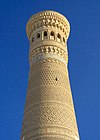
Bukhara is the seventh-largest city in Uzbekistan by population, with 280,187 residents as of 1 January 2020. It is the capital of Bukhara Region.

The Registan was the heart of the city of Samarkand of the Timurid Empire, now in Uzbekistan. The name Rēgistan (ریگستان) means "sandy place" or "desert" in Persian.

Navoiy is a city and the capital of Navoiy Region in the central part of Uzbekistan. Administratively, it is a district-level city, that includes the urban-type settlement Tinchlik. It is located at latitude 40° 5' 4N; longitude 65° 22' 45E, at an altitude of 382 meters. The city is named after Alisher Navoiy. As of 2024, its population was 161,300 inhabitants.

Itchan Kala is the walled inner town of the city of Khiva, Uzbekistan. Since 1990, it has been protected as a World Heritage Site.

Konye-Urgench, also known as Old Urgench or Urganj, was a city of about 30,000 inhabitants in north Turkmenistan, just south from its border with Uzbekistan. It is the site of the ancient town of Gurgānj, which contains the ruins of the capital of Khwarazm. Its inhabitants deserted the town in the early eighteenth century in order to develop a new settlement, and Konye-Urgench has remained undisturbed ever since. In 2005, the ruins of Old Urgench were inscribed on the UNESCO List of World Heritage Sites.
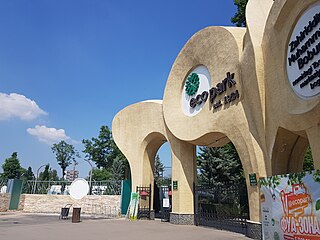
Tourism represents a substantial and fast-growing sector of the economy of Uzbekistan. The government of Uzbekistan under President Shavkat Mirziyoyev has invested heavily in developing tourism as a high-growth potential industry, resulting in an increase in international arrivals from approximately 1 million in 2016 to 7 million in 2023.
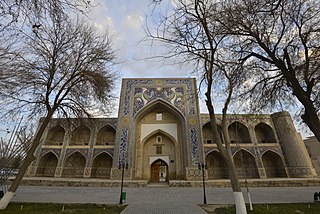
Lab-i Hauz, sometimes also known as Lyab-i Khauz, a Russian approximation, is the name of the area surrounding one of the few remaining hauz pools that have survived in the city of Bukhara, Uzbekistan. Until the Soviet period, there were many such pools, which were the city's principal source of water, but they were notorious for spreading disease and were mostly filled in during the 1920s and 1930s.

Po-i-Kalan, or Poi Kalan, is an Islamic religious complex located in Bukhara, Uzbekistan. The complex consists of three parts, the Kalan Mosque, the Kalan Minaret to which the name refers, and the Mir-i-Arab Madrasah. The positioning of the three structures creates a square courtyard in its center, with the Mir-i-Arab and the Kalan Mosque standing on opposite ends. In addition, the square is enclosed by a bazaar and a set of baths connected to the Minaret on the northern and southern ends respectively.

The Kalyan Minaret is a minaret of the Po-i-Kalyan mosque complex in Bukhara, Uzbekistan and one of the most prominent landmarks in the city.

Chor-Bakr is a memorial complex in the village of Sumitan at 5 km of Bukhara in Uzbekistan, built over the burial place of Abu-Bakr-Said, who died in the year 360 of the Muslim Calendar, and who was one of the four of Abu-Bakrs (Chor-Bakr) – descendants of Muhammad. The complex includes the necropolis of family tombs, and courtyards enclosed with walls.

Chashma-Ayub Mausoleum is located near the Samani Mausoleum, in Bukhara, Uzbekistan. Its name means Job's well, due to the legend in which Job (Ayub) visited this place and made a well by striking the ground with his staff. The water of this well is still pure and is considered healing. The current building was constructed during the reign of Timur and features a Khwarazm-style conical dome uncommon in Bukhara.

Nurota is a city and seat of Nurota District in Navoiy Region in Uzbekistan. Its population is 32,300 (2016).

Chorsu, also called Charsu, in Samarkand, Uzbekistan, is a domed, hexagonal shape building with central big dome and six small domes around central dome. Chorsu located at southeast of the Registan at the intersection of the roads connecting Samarkand, Tashkent, Bukhara, and Shahrisabz. Chorsu is a word of Tajik origin meaning "crossroads," referring to this intersection. The building is old, It has a rather rich centuries-old history. At the moment, it is included in the UNESCO World Heritage List along with the rest of the historical part of the city.
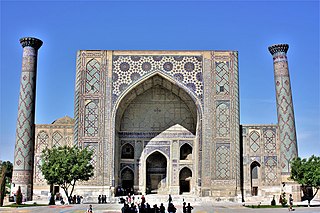
The Ulugh Beg Madrasa is a madrasa in the historic center of Samarkand, a UNESCO World Heritage Site in Uzbekistan. Together with other monuments, it forms the monumental ensemble of Registan, the old heart of the city. It was built between 1417 and 1421 by the then-Timurid governor of Samarkand, Ulugh Beg, Timur's grandson and prominent astronomer, who was later emperor between 1447 and 1449.

Chor Minor, alternatively known as the Madrasah of Khalif Niyaz-kul, is a historic gatehouse for a now-destroyed madrasa in the historic city of Bukhara, Uzbekistan. It is located in a lane northeast of the Lyab-i Hauz complex. It is protected as a cultural heritage monument, and also it is a part of the World Heritage Site Historic Centre of Bukhara. In Persian, the name of the monument means "four minarets", referring to the building's four towers.

Maghoki Attori Mosque is a historical mosque in Bukhara, Uzbekistan. It forms a part of the historical religious complex of Lyab-i Hauz. The mosque is located in the historical center of Bukhara, about 300 meters southwest of Po-i-Kalyan, 100 meters southwest of the Toqi Telpak Furushon trading dome and 100 meters east of Lab-i Hauz. It is a part of UNESCO World Heritage Site Historic Centre of Bukhara. Today, the mosque is used as a carpet museum.
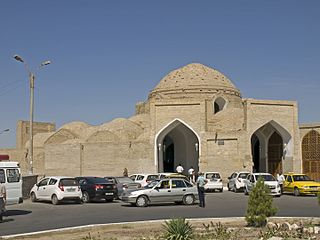
The Toqi Telpak Furushon is a bazaar located in Bukhara, which forms part of its historic centre. This architectural monument was built in 1571 during the reign of Shaibani ruler Abdullah Khan II. Currently, it is included in the national list of real estate objects of material and cultural heritage of Uzbekistan.

Toqi Sarrofon is an architectural monument and one of the main trade centers for money exchange in Bukhara. This architectural monument was built in 1534-1535 by the order of the Shaybanid ruler Ubaydullah Khan. It is currently included in the national register of immovable property of the material and cultural heritage of Uzbekistan.

Nodir Devonbegi Khanqah is a historical monument in the city of Bukhara, Uzbekistan. It was built by Nodir devonbegi, who was the vizier and nephew of Imam Quli Khan, the ruler of the Bukhara Khanate, in the years 1620–1621. The khanqah, which is a type of building that served as a place of residence and worship for Sufi mystics, is included in the national register of immovable property objects of the material and cultural heritage of Uzbekistan.
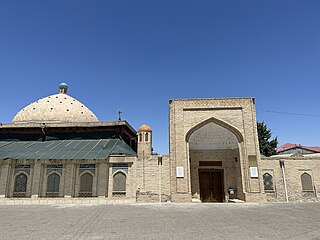
The Xalfa Xudoydod Complex is an architectural monument in Bukhara Region, Uzbekistan. The complex was built by Sheikh Xudoydod ibn Toshmuhammad Azizon al-Bukhari in 1777–1855, during the reign of the Manghit dynasty in Bukhara Emirate. The complex consists of a madrasa, a mosque, a house, a cistern and a cemetery.






















